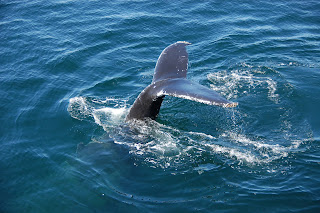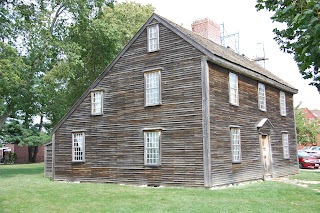Once we got onto the road with the camper, our drive to Plymouth was relatively short. We'll stay here, in the cradle of the European colonization of America, for the next seven days. We'll spend a lot of time venturing out from here...to Cape Cod, Martha's Vineyard, and Rhode Island. This afternoon, we visited the Pilgrim sites: Plymouth Rock, the Mayflower II, and Plimoth Plantation--a living history museum that interprets the colonists' village in 1627 (seven years after their arrival on the Mayflower) and a Native People's homesite. Additionally, the Plantation includes a craft barn, in which modern artisans replicate the pottery, weaving, wood carving and sewing that would have taken place in the 1627 settings.
The girls' ears were challenged by the Old English dialect used by the interpretters in the colonist village. And we learned much about the native Wampanoag people who traded with and helped the English arrivals. The tribes had been decimated by European diseases in the years prior to the pilgrims' arrival; the English took the empty villages of the native people to be a sign of God's approval of their plans to colonize the area. So many aspects of the pilgrim story are hard to hear, much less accept as our heritage. Nevertheless, we all learned a great deal and enjoyed our interactions with the costumed interpretters.
The Mayflower II is a full-scale replica of the original Mayflower that brought the pilgrims in 1620. It was built in England in the 1950s and sailed to her new home in Plymouth in 1957. We were struck by how small the ship is...and to think of the 102 pilgrims being stuck below deck (in a cargo ship without windows, not intended for passengers) for nearly the entire voyage and then living on her for months beyond their arrival! The man who "hosted" us onboard the ship said that records indicate the passengers spent approximately eight hours in the fresh air for the entire nine weeks under sail. The decks would have been a hive of dangerous activity for the crew, who were battling rough seas and the potential of hurricanes. About half of the passengers were pilgrims, people who sought a place in which to practice their form of religion without the prejudices they had faced in England and, later, Holland. The other passengers were adventurers, of sorts: people who were hired by English investors to make a go of a colony in the New World, creating a new stream of natural resources from which to profit. Nearly half of the colonists died that first winter. But by 1627, the village had grown thanks to new arrivals, swelling the population to more than 160. In just a few years' time, Plymouth Colony began to shrink; it was overshadowed by the newer and more prosperous Massachusetts Bay Colony (established in 1630), and many of the Plymouth inhabitants ended up in Boston.
We're experiencing the story backwards, having begun our education about colonists while in Boston and now picking up the earlier chapters here in Plymouth. We also were glad to see Plymouth Rock, which supposedly marks the site of the pilgrims' first steps in the New World. Whether or not it marks the actual place, it serves as a memorial to brave and fiercely determined people, who believed in their faith, their abilities and the potential of this unknown land to provide a better life.
 |
| Entering 1627 |
 |
| Gathering mint with Mary |
 |
| Plymouth Colony village |
 |
| Mayflower II |













































